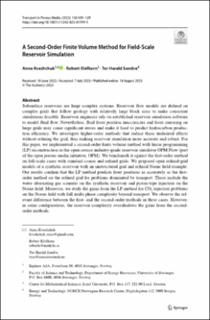| dc.contributor.author | Kvashchuk, Anna | |
| dc.contributor.author | Klöfkorn, Robert | |
| dc.contributor.author | Sandve, Tor Harald | |
| dc.date.accessioned | 2023-10-12T11:35:46Z | |
| dc.date.available | 2023-10-12T11:35:46Z | |
| dc.date.created | 2023-09-20T12:48:20Z | |
| dc.date.issued | 2023-08 | |
| dc.identifier.citation | Kvashchuk, A., Klöfkorn, R. & Sandve, T.H. (2023) A Second-Order Finite Volume Method for Field-Scale Reservoir Simulation. Transport in Porous Media, 150, 109-129. | en_US |
| dc.identifier.issn | 0169-3913 | |
| dc.identifier.uri | https://hdl.handle.net/11250/3096080 | |
| dc.description.abstract | Subsurface reservoirs are large complex systems. Reservoir flow models are defined on complex grids that follow geology with relatively large block sizes to make consistent simulations feasible. Reservoir engineers rely on established reservoir simulation software to model fluid flow. Nevertheless, fluid front position inaccuracies and front smearing on large grids may cause significant errors and make it hard to predict hydrocarbon production efficiency. We investigate higher-order methods that reduce these undesired effects without refining the grid, thus making reservoir simulation more accurate and robust. For this paper, we implemented a second-order finite volume method with linear programming (LP) reconstruction in the open-source industry-grade reservoir simulator OPM Flow (part of the open porous media initiative, OPM). We benchmark it against the first-order method on full-scale cases with standard coarse and refined grids. We prepared open refined-grid models of a synthetic reservoir with an unstructured grid and refined Norne field example. Our results confirm that the LP method predicts front positions as accurately as the first-order method on the refined grid for problems dominated by transport. These include the water alternating gas scenario on the synthetic reservoir and piston-type injection on the Norne field. Moreover, we study the gains from the LP method for CO2 injection problems on the Norne field with full multi-phase complexity beyond transport. We observe the relevant difference between the first- and the second-order methods in these cases. However, in some configurations, the reservoir complexity overshadows the gains from the second-order methods. | en_US |
| dc.language.iso | eng | en_US |
| dc.publisher | Springer Nature Switzerland AG | en_US |
| dc.rights | Navngivelse 4.0 Internasjonal | * |
| dc.rights.uri | http://creativecommons.org/licenses/by/4.0/deed.no | * |
| dc.subject | geologi | en_US |
| dc.title | A Second-Order Finite Volume Method for Field-Scale Reservoir Simulation | en_US |
| dc.type | Peer reviewed | en_US |
| dc.type | Journal article | en_US |
| dc.description.version | publishedVersion | en_US |
| dc.rights.holder | © 2023, The Author(s) | en_US |
| dc.subject.nsi | VDP::Matematikk og Naturvitenskap: 400::Geofag: 450 | en_US |
| dc.source.pagenumber | 109-129 | en_US |
| dc.source.volume | 150 | en_US |
| dc.source.journal | Transport in Porous Media | en_US |
| dc.identifier.doi | 10.1007/s11242-023-01999-1 | |
| dc.identifier.cristin | 2177041 | |
| cristin.ispublished | true | |
| cristin.fulltext | original | |
| cristin.qualitycode | 2 | |

